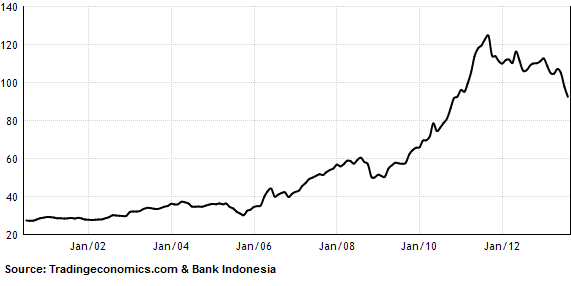Be aware that there are scammers active on WA pretending to be Indonesia Investments
11 May 2025 (closed)
Jakarta Composite Index (6,832.80) +5.05 +0.07%
Indonesia's Foreign Exchange Reserves Fall, Current Account Deficit Grows
The foreign exchange reserves of Indonesia keep on falling from its historical peak of USD $124.64 billion in August 2011 to USD $92.67 billion at the end of July 2013. This development seems to highlight long-standing weaknesses in Indonesia's sovereign's external finances, as credit agency Fitch Ratings detected on several occasions before. The republic of Indonesia is currently characterized by four deficits, to wit a current account deficit, a balance of payments deficit, a trade balance deficit and a fiscal deficit.
Foreign Exchange Reserves of Indonesia, 2000-2013 (in USD billion):

In 2012, Indonesia posted its first annual current account deficit since 1997 at about 2.74 percent of GDP. However, this deficit was offset by the country's capital and financial account surplus. Indonesia's balance of payments recorded a surplus of USD $3.2 billion in 2012. In the first quarter of 2013, however, the balance of payments has been in deficit (USD $6.6 billion). The sharply falling balance of payments since 2010 raises the question whether Indonesia's economic expansion is sustainable, particularly as foreign investments have been experiencing a slowdown recently.
| 2009 |
2010 | 2011 | 2012 | 2013 | |
| Current Account Deficit (US$ billion) |
10.63 | 5.64 | 1.69 | -24.07 | -5.27¹ |
| Balance of Payments (US$ billion) |
12.51 | 30.29 | 11.86 | 3.22 | -6.62¹ |
| Foreign Exchange Reserves (US$ billion) |
66.1 | 96.2 | 110.1 | 112.8 | 92.7² |
¹ Quarter I 2013
² at 31 July 2013
Source: Bank Indonesia
In February 2013, Fitch Ratings stated that the emergence of a current account deficit is not unusual for an economy at Indonesia's stage of economic development, but does highlight a greater reliance on external sources of financing and heightens Indonesia's exposure to short term debt capital flows.
Concerns about Indonesia's current account deficit have put pressure on the IDR rupiah. This has made Bank Indonesia decide to use part of its foreign exchange reserves to support the rupiah. Continued global economic turmoil resulted in weak exports (especially Indonesian commodities), while robust domestic demand has resulted in higher imports; a situation that has impacted negatively on the current account balance. Bank Indonesia expects the current account deficit to reach USD $9 billion in the April-June 2013 period, equivalent to 3.6 percent of the country's gross domestic product.
Foreign ownership of Indonesian government bonds stood at IDR 288 trillion at the start of this week, down from its peak of IDR 303 trillion in May 2013. Apart from global uncertainty regarding the Federal Reserve's quantitative easing program, higher inflation in Indonesia (8.61 percent YoY in July 2013) also makes it less attractive to hold rupiah-denominated assets.
Indonesia's foreign exchange reserves are those foreign assets that are held - or controlled - by the country's central bank (Bank Indonesia). These reserves consist of gold, specific currencies, or special drawing rights and marketable securities denominated in foreign currencies (which include treasury bills, government bonds, corporate bonds and equities, and foreign currency loans).
